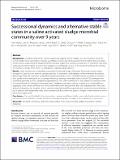Successional dynamics and alternative stable states in a saline activated sludge microbial community over 9 years
Author(s)
Wang, Yulin; Ye, Jun; Ju, Feng; Liu, Lei; Boyd, Joel A.; Deng, Yu; Parks, Donovan H.; Jiang, Xiaotao; Yin, Xiaole; Woodcroft, Ben J.; Tyson, Gene W.; Hugenholtz, Philip; Polz, Martin F.; ... Show more Show less
Download40168_2021_Article_1151.pdf (7.198Mb)
Publisher with Creative Commons License
Publisher with Creative Commons License
Creative Commons Attribution
Terms of use
Metadata
Show full item recordAbstract
Background
Microbial communities in both natural and applied settings reliably carry out myriads of functions, yet how stable these taxonomically diverse assemblages can be and what causes them to transition between states remains poorly understood. We studied monthly activated sludge (AS) samples collected over 9 years from a full-scale wastewater treatment plant to answer how complex AS communities evolve in the long term and how the community functions change when there is a disturbance in operational parameters.
Results
Here, we show that a microbial community in activated sludge (AS) system fluctuated around a stable average for 3 years but was then abruptly pushed into an alternative stable state by a simple transient disturbance (bleaching). While the taxonomic composition rapidly turned into a new state following the disturbance, the metabolic profile of the community and system performance remained remarkably stable. A total of 920 metagenome-assembled genomes (MAGs), representing approximately 70% of the community in the studied AS ecosystem, were recovered from the 97 monthly AS metagenomes. Comparative genomic analysis revealed an increased ability to aggregate in the cohorts of MAGs with correlated dynamics that are dominant after the bleaching event. Fine-scale analysis of dynamics also revealed cohorts that dominated during different periods and showed successional dynamics on seasonal and longer time scales due to temperature fluctuation and gradual changes in mean residence time in the reactor, respectively.
Conclusions
Our work highlights that communities can assume different stable states under highly similar environmental conditions and that a specific disturbance threshold may lead to a rapid shift in community composition.
Video Abstract
Date issued
2021-10Department
Massachusetts Institute of Technology. Department of Civil and Environmental EngineeringJournal
Microbiome
Publisher
BioMed Central
Citation
Wang, Y., Ye, J., Ju, F. et al. Successional dynamics and alternative stable states in a saline activated sludge microbial community over 9 years. Microbiome 9, 199 (2021).
Version: Final published version
ISSN
2049-2618